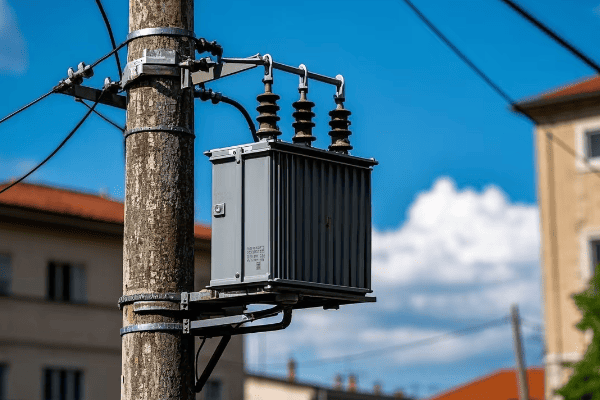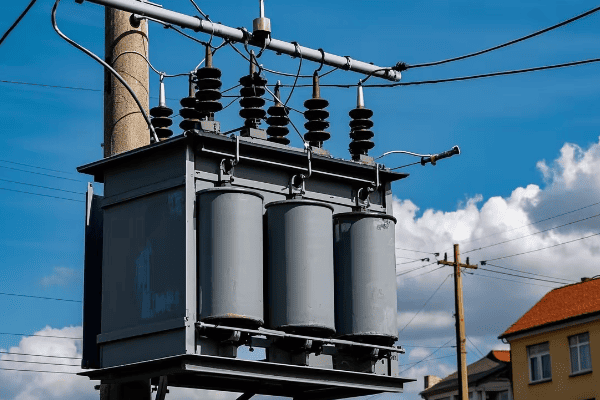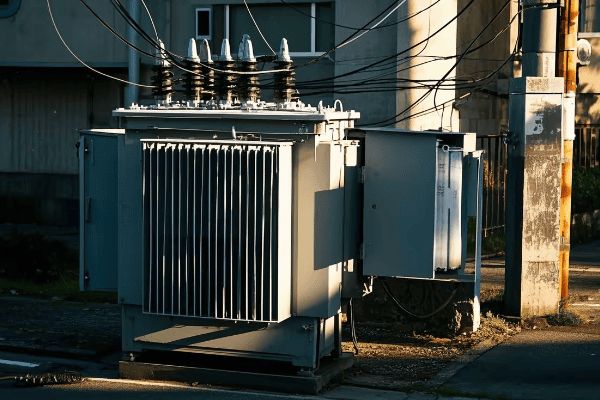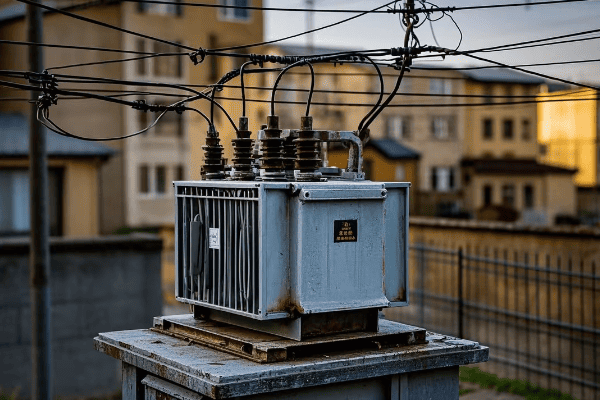How Does an Electrical Transformer Work: Unveiling the Core Principles of Power Distribution?
Have you ever wondered how electricity travels safely from power plants to your home? The answer lies in a device you rarely see but heavily rely on: the electrical transformer.
Electrical transformers work by using electromagnetic induction to change voltage levels. They transfer electrical energy between two or more circuits, enabling efficient power transmission over long distances and safe distribution to homes and businesses. This process is fundamental to our modern power grid.

As an electrical engineer with years of experience in the power industry, I’ve seen firsthand how crucial these devices are. Let’s dive into the fascinating world of electrical transformers and uncover the principles that keep our lights on.
The Anatomy of an Electrical Transformer: Understanding Its Key Components?
Imagine trying to understand how a car works without knowing its parts. The same goes for transformers. Knowing their components is key to grasping their function.
An electrical transformer consists of several key components: the core, primary and secondary windings, insulation, and cooling system. Each part plays a crucial role in the transformer’s operation, working together to efficiently change voltage levels and transfer power.

Let’s break down the anatomy of a transformer:
1. The Core
The core is the heart of the transformer:
- It’s usually made of thin layers of silicon steel.
- These layers, called laminations, reduce energy losses.
- The core provides a path for the magnetic field.
2. Windings
Transformers have two sets of windings:
- Primary Winding: Connects to the input power source.
- Secondary Winding: Delivers the output power.
- The ratio of turns in these windings determines the voltage change.
3. Insulation
Insulation is crucial for safety and efficiency:
- It prevents short circuits between windings and the core.
- Common insulation materials include paper, oil, and resin.
4. Cooling System
Transformers generate heat, so cooling is essential:
- Small transformers often use air cooling.
- Larger ones use oil for both cooling and insulation.
5. Tap Changer
Some transformers have tap changers:
- These adjust the turn ratio slightly.
- They help maintain consistent output voltage.
Here’s a table summarizing the key components:
| Component | Function | Material |
|---|---|---|
| Core | Provides magnetic path | Silicon steel laminations |
| Primary Winding | Receives input power | Copper or aluminum wire |
| Secondary Winding | Delivers output power | Copper or aluminum wire |
| Insulation | Prevents short circuits | Paper, oil, resin |
| Cooling System | Manages heat | Air or oil |
| Tap Changer | Adjusts voltage ratio | Mechanical or electronic switch |
I remember the first time I opened up a large power transformer. The complexity inside was astounding. The carefully wound coils, the massive core, and the intricate cooling systems all worked together in a delicate balance. It gave me a new appreciation for these devices that we often take for granted.
Understanding the anatomy of a transformer is just the first step. Each component plays a crucial role in the transformer’s operation, and they all work together to perform the seemingly magical task of changing voltage levels. This knowledge forms the foundation for understanding how transformers function in our power distribution systems.
Electromagnetic Induction: The Fundamental Principle Behind Transformer Operation?
Have you ever been amazed by a magician pulling a rabbit out of a hat? Well, transformers perform a similar magic with electricity, and the secret behind their trick is electromagnetic induction.
Electromagnetic induction is the core principle behind transformer operation. When an alternating current flows through the primary winding, it creates a changing magnetic field in the core. This field then induces a voltage in the secondary winding, allowing power transfer between circuits.

Let’s dive deeper into this fascinating principle:
The Basics of Electromagnetic Induction
Electromagnetic induction was discovered by Michael Faraday in 1831. Here’s how it works:
- A changing magnetic field creates an electric field.
- This electric field can induce a voltage in a nearby conductor.
- If the conductor is part of a closed circuit, a current will flow.
How Transformers Use This Principle
Transformers cleverly apply electromagnetic induction:
- The primary winding receives AC power, creating a changing magnetic field.
- The core channels this magnetic field to the secondary winding.
- The changing field induces a voltage in the secondary winding.
- The induced voltage depends on the turns ratio between primary and secondary windings.
The Role of Alternating Current
Transformers only work with AC power. Here’s why:
- AC constantly changes direction, creating a changing magnetic field.
- This changing field is crucial for continuous induction.
- DC would only create a momentary induction when turned on or off.
The Importance of the Core
The transformer’s core enhances the induction process:
- It provides a low-reluctance path for the magnetic field.
- This concentrates the field, making the transformer more efficient.
- The laminated design minimizes energy losses due to eddy currents.
Here’s a simplified comparison of induction with and without a core:
| Aspect | Air Core | Iron Core |
|---|---|---|
| Magnetic Field Strength | Weaker | Stronger |
| Efficiency | Lower | Higher |
| Size for Same Power | Larger | Smaller |
| Typical Use | High-frequency applications | Power distribution |
I once had the opportunity to demonstrate electromagnetic induction to a group of students. We used a simple hand-crank generator connected to a small transformer. As I turned the crank, the students could see the output voltage change on a meter. Their eyes lit up when they realized they were witnessing the same principle that powers our entire electrical grid. It was a powerful reminder of how fundamental this concept is to our modern world.
Understanding electromagnetic induction is key to grasping how transformers work. It’s the invisible force that allows these devices to change voltage levels and transfer power between circuits. This principle, discovered nearly two centuries ago, continues to be the backbone of our power distribution systems, enabling the electrical conveniences we enjoy every day.
Transformer Types Demystified: From Step-Up to Step-Down and Beyond?
Have you ever wondered why we need different types of transformers? It’s like having different tools in a toolbox – each has its specific purpose in our power distribution system.
Transformers come in various types, each designed for specific roles in power distribution. The main categories include step-up transformers for increasing voltage, step-down transformers for decreasing voltage, and isolation transformers for safety. Each type plays a crucial role in ensuring efficient and safe power delivery.

Let’s explore the main types of transformers and their unique roles:
1. Step-Up Transformers
These are the powerhouses of our transmission system:
- They increase voltage for long-distance transmission.
- Typically found at power plants.
- They reduce current, minimizing power losses over long distances.
2. Step-Down Transformers
These bring power closer to our homes:
- They decrease voltage for local distribution.
- Found at substations and on utility poles.
- They make electricity safe for residential and commercial use.
3. Isolation Transformers
These are the safety guards of our electrical systems:
- They transfer power between circuits without a direct electrical connection.
- Useful in sensitive electronic equipment.
- They help prevent electric shock and reduce noise in circuits.
4. Autotransformers
These are the space-savers:
- They use a single winding for both primary and secondary.
- More efficient for small voltage changes.
- Often used in voltage regulators.
5. Instrument Transformers
These are the measuring tools:
- They include current transformers (CTs) and potential transformers (PTs).
- Used for measuring high currents and voltages safely.
- Essential for metering and protection systems.
Here’s a comparison table of these transformer types:
| Type | Primary Use | Voltage Change | Typical Location |
|---|---|---|---|
| Step-Up | Increase voltage | Low to High | Power plants |
| Step-Down | Decrease voltage | High to Low | Substations, neighborhoods |
| Isolation | Safety, noise reduction | No change | Sensitive equipment, medical facilities |
| Autotransformer | Small voltage adjustments | Slight increase or decrease | Voltage regulators, railway systems |
| Instrument | Measurement | High to Low | Throughout power system |
I once worked on a project to upgrade a small town’s electrical infrastructure. We needed to use almost every type of transformer mentioned above. The step-up transformer at the local hydroelectric plant, the step-down transformers at the substation, isolation transformers for the hospital’s sensitive equipment, and instrument transformers for the new smart metering system. It was like conducting an orchestra, with each transformer playing its unique part in the symphony of power distribution.
Understanding these different types of transformers is crucial for anyone involved in electrical systems. Each type has its strengths and ideal applications. By using the right transformer for each job, we ensure that our power grid remains efficient, safe, and reliable. From the massive transformers at power plants to the small ones powering your electronic devices, each plays a vital role in bringing electricity to our fingertips.
Voltage Manipulation: How Transformers Adapt Power for Distribution Needs?
Have you ever tried to fit a square peg in a round hole? That’s what using electricity would be like without transformers adapting voltage for our various needs.
Transformers adapt power for distribution needs by manipulating voltage levels. They use the principle of electromagnetic induction and the turns ratio between their primary and secondary windings to increase or decrease voltage. This ability is crucial for efficient power transmission and safe consumption.

Let’s dive into how transformers perform this crucial voltage manipulation:
The Turns Ratio Principle
The key to voltage manipulation lies in the turns ratio:
- It’s the ratio of turns in the primary winding to turns in the secondary winding.
- This ratio determines the voltage change.
- The formula is: Voltage Primary / Voltage Secondary = Turns Primary / Turns Secondary
Step-Up Transformation
Used at power plants to prepare electricity for long-distance transmission:
- The secondary winding has more turns than the primary.
- This increases the voltage and decreases the current.
- Lower current means less power loss in transmission lines.
Step-Down Transformation
Used to bring high transmission voltages down for local distribution:
- The secondary winding has fewer turns than the primary.
- This decreases the voltage to safer levels for local use.
- It happens in stages, from substations to local transformers.
Fine-Tuning with Tap Changers
Some transformers can adjust their voltage ratio slightly:
- They use devices called tap changers.
- These can adjust the number of active turns in a winding.
- Useful for maintaining steady voltage despite fluctuations in supply or demand.
Here’s a table showing typical voltage changes in the power distribution system:
| Stage | Input Voltage | Output Voltage | Transformer Type |
|---|---|---|---|
| Generation | 20 kV | 345 kV | Step-Up |
| Transmission | 345 kV | 345 kV | None (transmission lines) |
| Sub-transmission | 345 kV | 69 kV | Step-Down |
| Distribution | 69 kV | 12 kV | Step-Down |
| Residential | 12 kV | 120/240 V | Step-Down |
I remember working on a project to integrate a new solar farm into the local grid. The challenge was that the solar panels produced DC at low voltage, but we needed AC at much higher voltage for the grid. We used a series of transformers: first, an inverter to convert DC to AC, then a step-up transformer to increase the voltage for transmission. At each substation, step-down transformers brought the voltage down in stages. It was a perfect example of how transformers adapt power at every stage of the journey from generation to consumption.
Voltage manipulation by transformers is what makes our modern power distribution system possible. Without it, we couldn’t transmit power efficiently over long distances or use it safely in our homes. Every time you plug in a device, you’re benefiting from this invisible but crucial process of voltage adaptation. Transformers truly are the unsung heroes of our electrical world, working tirelessly to ensure we have the right power for every need.
Efficiency and Safety: The Critical Role of Transformers in Power Transmission?
Imagine trying to carry water in a leaky bucket. That’s what power transmission would be like without efficient transformers. And using that power? It would be as dangerous as juggling live wires.
Transformers play a critical role in ensuring both efficiency and safety in power transmission. They minimize energy losses during long-distance transmission by enabling high-voltage, low-current power flow. At the distribution end, they step down voltage to safe levels for consumer use, protecting both people and equipment.

Let’s explore how transformers contribute to efficiency and safety in our power systems:
Efficiency in Power Transmission
Transformers are key to efficient power transmission:
-
Enabling High-Voltage Transmission:
- Step-up transformers increase voltage at power plants.
- Higher voltage means lower current for the same power.
- Lower current results in reduced I²R losses in transmission lines.
-
Minimizing Core Losses:
- Modern transformers use advanced core materials like grain-oriented silicon steel.
- These materials reduce hysteresis and eddy current losses.
-
Cooling Systems:
- Efficient cooling helps reduce resistance and improve overall efficiency.
- Large transformers often use oil cooling for better heat dissipation.
Safety in Power Distribution
Transformers are crucial for electrical safety:
-
Voltage Step-Down:
- They reduce high transmission voltages to levels safe for local distribution and home use.
- This protects consumers from dangerous high voltages.
-
Electrical Isolation:
- Transformers provide galvanic isolation between primary and secondary circuits.
- This helps prevent ground faults from propagating through the system.
-
Fault Current Limitation:
- The impedance of transformers helps limit fault currents.
- This can prevent more severe damage during short circuits.
Here’s a comparison of efficiency and safety aspects in power systems with and without transformers:
| Aspect | Without Transformers | With Transformers |
|---|---|---|
| Transmission Efficiency | Low (high losses) | High (minimal losses) |
| Transmission Distance | Limited | Long distances possible |
| Consumer Voltage | Potentially dangerous | Safe, standardized levels |
| Fault Isolation | Poor | Good |
| System Flexibility | Limited | High (easy voltage conversion) |
I once worked on a project to upgrade an old industrial power system. The facility was experiencing frequent equipment failures and high energy costs. By installing modern, high-efficiency transformers at key points in their power distribution system, we were able to reduce energy losses by 15% and virtually eliminate equipment failures due to power quality issues. The plant manager was amazed at how these seemingly simple devices could have such a profound impact on both their energy efficiency and operational safety.
Transformers are truly the unsung heroes of our power systems. They work silently and continuously to ensure that electricity is transmitted efficiently over long distances and distributed safely to end-users. Without them, our modern electrical grid simply wouldn’t be possible. From the massive transformers at power plants to the small ones on utility poles in your neighborhood, each plays a vital role in delivering power efficiently and safely to our homes and businesses.
Conclusion
Electrical transformers are fundamental to modern power distribution. They use electromagnetic induction to change voltage levels, enabling efficient transmission and safe usage. From power plants to our homes, transformers ensure electricity is delivered reliably and safely, powering our world.
Free CHBEB Transformer Catalog Download
Get the full range of CHBEB transformers in one catalog.
Includes oil-immersed, dry-type, pad-mounted, and custom solutions.
Quick Message
Request A free quote
We'd like to work with you
- +86 15558785111
- [email protected]
- +86 15558785111
What We Do
CHINA BEI ER BIAN (CHBEB) GROUP, with 218 million in registered capital, originated from Beijing Beierbian Transformer Group. Headquartered in Beijing for R&D, it operates major production bases in Nanjing and Yueqing, producing high-quality products.
Latest Product
address
BeiJing
No 3,RongJing East Road,BeiJing Economic Technological Development Area,BeiJing,China
JiangSu
No 7️Xiangfeng Road,Jiangning,NanJing,JiangSu,China
WenZhou
No.211, Wei 16 Road, Industrial Zone, Yueqing, Wenzhou, Zhejiang, China.
XiangYang Industrial Zone ,YueQing,WenZhou,ZheJiang,China
contact us
- [email protected]
- +86 13057780111
- +86 13057780111
- +86 15558785111
Copyright © Bei Er Bian Group


